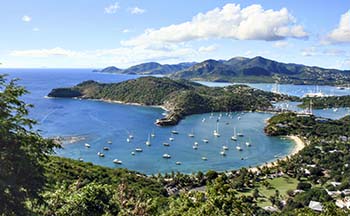
English Harbor from above.
Approaching Antigua from the air is breathtaking! The marked contrasts of greenery in the higher hills fall sharply from towering cliffs into the deep blue of the sea. Other sections of the island possess long, shallow flats exhibiting an unforgettable turquoise shade that changes gradually as it descends into the open ocean. Antigua (www.visitantiguabarbuda.com) is truly the best tropical paradise in the Leeward Islands of the Caribbean.
One quickly notices the British influence in the language and the right-hand drive vehicles that motor down the wrong side of the road. Also, the billboards and conversation on Antigua often turns to cricket, which seems to be the passion of everyone on the island. In fact, the local culture is so absorbed in this English game that matches may be playing anywhere and at any time. Official cricket events, however, are scheduled Thursdays, Saturdays, and Sundays. The cricket season lasts from January to July and is interspersed with regional and international matches that are held in outstanding facilities.
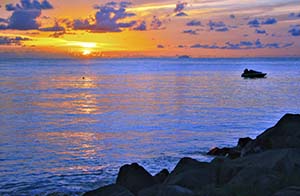
An Antiqua Sunset.
Though Siboney, Arawak and Carib Indians had inhabited Antigua as early as 2400 BC, the first European connection was made when Christopher Columbus passed and named the island on his second voyage in 1493. The first colony was set up by the British in 1632, and within 50 years, the island began the sugar era with slaves from Africa. Today, the majority of the Antiguan population is tied directly to those Africans who toiled for years in the sugarcane fields and operated the hundreds of mills. The remnants of those structures, built from the ballast stones of merchant ships, have become a distinctive trademark of Antigua. They appear as stone pillboxes and are scattered all over the island as a reminder of the past.
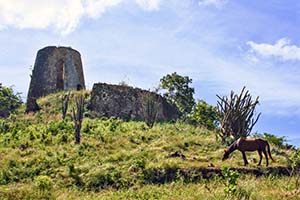
An Ancient Sugar Mill in Antigua
By the end of the 18th century Antigua had become an important strategic port as well as a priceless commercial colony. Horatio Nelson arrived in 1784 to enforce inflexible shipping laws. Serving under Nelson at the time was the future King William IV, who abolished slavery in 1834 throughout the British Empire. Today, Antigua’s Carnival festivities commemorate the earliest abolition of slavery in the British Caribbean.
After the decline of the sugar industry and before the current tourism boom, most islanders struggled to survive. Since becoming an independent country in 1981, however, Antigua has incorporated its natural beauty, British history and wonderful, friendly people into a tropical Mecca for tourists. This is especially seen and experienced in the areas around Jolly Beach, English Harbor and St. Johns.
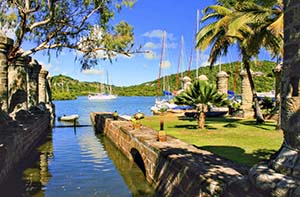
One of the old ship repair areas in Nelson’s Dockyard at English Harbor.
Across the island, English Harbor was developed as a major British Navy base during the romantic age of great sailing vessels in the 18th century. The largest expansion occurred while Horatio Nelson was in command, thus the name “Nelson’s Dockyard.” It has been completely restored and is the only remaining Georgian dockyard in the world. Many English people have made their homes in this area in recent times as well.
Far above the harbor, the partially restored fortifications at Shirley Heights remind visitors of another era. This historic site affords anyone a magnificent panorama of English Harbor below and the volcanic island of Montserrat located some 30 miles away. On Sunday afternoons, the breathtaking view is enhanced by barbecue, rum punch and the sounds of a steel band and reggae music.
For those who love the hustle and bustle of city life, a visit to St. John’s must be included in the plans on Friday or Saturday morning. The farmers market on the southern edge of the city is THE place to see and purchase local crafts, colorful tropical fruits and a virtual plethora of other interesting items.
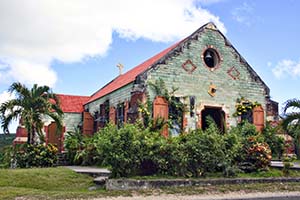
An old church on Antiqua.
Certainly, the most prevalent structure in St. John’s is the Cathedral which is easily identifiable by its stately, white baroque towers. Built in 1845, the church is now in its third incarnation, as earthquakes in 1683 and 1745 destroyed the previous structures. Also worth a visit is the Museum of Antigua and Barbuda which is housed in the old Colonial Court House built in 1750. One can browse through both the physical and archaeological history of the islands in less than an hour at no cost.
The cooler trade winds that brought the ancient sailing ships to Antigua still make this island a perfectly comfortable place to visit. It has to be considered one of the top holiday and vacation destinations in the world, with superb beaches, hotels, private accommodation, a vibrant culture, excellent restaurants and nightlife, a huge choice of tours and excursions and some of the friendliest people in the world!
Photos: by Bill Vanderford



